sorry for the lack of posting but my camera has a terminal illness and I have no medical insurance to pay for treatment.
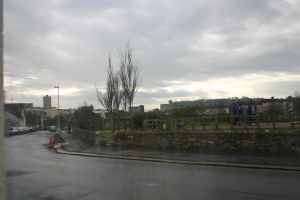
To the left…
On a nice day I can see past the ferry port to Mount Edgecombe ( on the centre right of the horizon), on a bad day I can just about see the play park!!!
To the right…
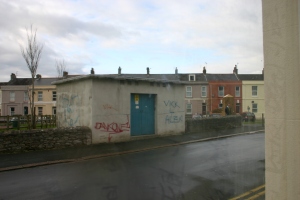
the electrical sub station has now been painted green, so it blends in with the grass!!
Posted in Uncategorized | Tagged buildings, city, clouds, grass, houses, plymouth, sky | Leave a Comment »
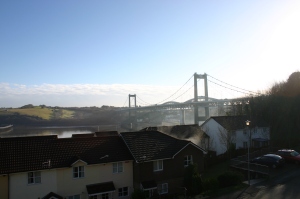
The Tamar Bridge is a major road bridge at Saltash in southwest England carrying traffic between Cornwall and Devon. When it opened in 1961 it was the longest suspension bridge in the United Kingdom. In 2001 it became the world’s first suspension bridge to be widened (from three to five lanes) using cantilevers, and the world’s first bridge to undergo strengthening and widening work while remaining open to traffic.
Construction of the Tamar Bridge began in July 1959. Before this, the lowest road crossing of the River Tamar was Gunnislake New Bridge at the village of Gunnislake.
Before the Tamar Bridge was opened, most car drivers wishing to travel between Saltash (on the Cornish side) and the Devon city of Plymouth used car ferries. Today the Tamar Bridge carries approximately 40 000 vehicles every day. It is co-owned by Plymouth City Council and Cornwall County Council.
The Bridge was officially opened by HRH the Queen Mother on April 26th 1962 when she cut a tape on the Plymouth side and walked across the bridge to meet the Mayor of Saltash on the Cornish side of the river.
Posted in Uncategorized | Tagged cantilevers, cornwall, devon, plymouth, river tamar, road bridge, saltash, suspension bridge | 1 Comment »
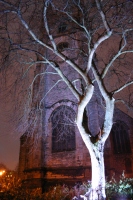
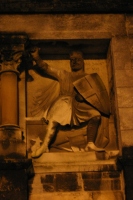
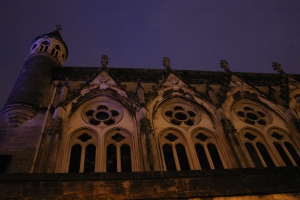
In 1869 plans were invited for the design of a new Guildhall to replace the one at the top of the High Street. Twenty sets of plans were received.
The Guildhall was built in 1873 by Mr John Pethick, later Mayor of Plymouth. The Guildhall block was opened on Thursday August 13th 1874 by HRH the Prince of Wales, (later to become King Edward VII).
Badly damaged in WWII it was restored in the 1950s.The Guildhall and Municipal Offices managed to survive the first night of the Plymouth Blitz but were gutted by fire during the night of March 21st/22nd 1941. Only two months before, when the City was short of cooking facilities, hundreds of Plymothians had packed the Guildhall for a very welcome hot lunch. As a result of this damage, the Guildhall was very nearly demolished. In fact when the Minister of Works, Mr R R Stokes, visited the site on Saturday July 22nd 1950, he said that: ‘the whole building should be knocked down and a fresh start made.‘
Work started early in January 1953 and by March over 1,000 tons of debris had been cleared away, most of it dumped on The Hoe and some in Stonehouse Creek. Interestingly, no plans of the Guildhall existed and surveyors had to record all the dimensions of the building while this work was in progress.
The restoration work started on June 30th 1954, some six months later than planned.
Posted in Uncategorized | Tagged architecture, blitz, church, gothic, guildhall, knight, night, plymouth, tree | 1 Comment »
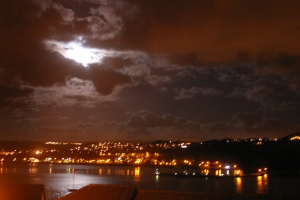
Picture taken from Saltash, view of Ernesettle.
Posted in Uncategorized | Tagged clouds, cornwall, devon, ernesettle, moon, night, reflections, river tamar, saltash, sky, street lights | 2 Comments »

As one of only four remaining further and higher specialist art and design colleges in the country, the College provides a role locally, regionally, nationally and internationally in providing excellence in Art and Design education and training
Posted in Uncategorized | Tagged art, art and design, college, design, learning, plymouth | Leave a Comment »
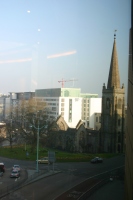
Charles Church was situated in Vennel Street before the Second World War. It was reputedly one of the last Gothic churches to be built, before the style disappeared.
The Church is now in the centre of the Charles Cross roundabout, preserved as a monument to those civilians who died in Plymouth during the Second World War.
Charles Church was destroyed during the night of March 20th/21st 1941 and consequently nothing remains of the interior. The Council’s Reconstruction Committee resolved on June 15th 1953 that the Council should acquire and demolish the Church. Despite continued cries for it to be demolished, it has been retained and on Saturday November 1st 1958 the Reverend J Allen James, vicar of Charles with St Luke, dedicated it as a fitting memorial to Plymouth’s 1,200 civilian dead in the Second World War.
The remains of those buried in the churchyard that surrounded Charles Church have been re-interred at Efford Cemetery.
Posted in Uncategorized | Tagged architecture, bomb damaged, church, derelict, gothic, memorial, plymouth, religion, roundabout, worship | 3 Comments »

The Plymouth Central Library is situated in Tavistock Road, opposite the University of Plymouth. It was opened in 1910 in a dual ceremony with the City of Plymouth Museum and Art Gallery.
The final cost of the work is said to have been £15,627 14s 6d for the Library.
Then on the night of April 22nd/23rd 1941 the building and some 72,000 volumes were lost, including 41,000 in the lending library, 16,000 in the reference department and the Devon and Cornwall Collection of 15,000 books. Luckily there were 5,000 books out on loan, which were largely saved. Some of the stock was salvaged but it was only thanks to the general public donating 4,500 books that a library service was able to recommence as quickly as it did.
The Plymouth Proprietary Library, now situated at the top of North Hill, is the oldest library in the City. It was founded at a meeting held on Wednesday November 20th 1811.
On the evening of Monday July 16th 1962 the Commander-in-Chief, Plymouth, Admiral Sir Charles Madden, officially presented 15,000 naval books from the Port Library and Plymouth Command Officers’ Library to the City to form the Naval Studies section of the Plymouth Library Service. It was to be known as “The Mount Wise Collection”.
Posted in Uncategorized | Tagged books, history, library, mount wise collection, naval history | 1 Comment »
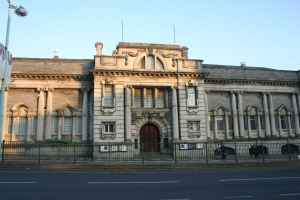
Plymouth’s first museum was a part of the Plymouth Institution’s Athenaeum building in George Street, next to the Theatre Royal.
In 1898 the Corporation started their own museum at Beaumont House and finally, in 1910, the present building, pictured above was opened in Tavistock Road.
In 1887 the Corporation resolved to create a museum and art gallery to mark the Jubilee of Queen Victoria’s accession to the Throne. A site was donated by the Town at the Old Town Hills in Tavistock Road and when in 1890 they were able to purchase Beaumont House and grounds off the trustees of the late Reverend Thomas Archer Bewes, they used the House as a temporary place of storage for artifacts and paintings.
The first public exhibition was opened on Monday August 1st 1898, when just over one hundred pictures of mainly local scenes, were put on display.
Although a part of the same block of buildings, the Library and the Museum and Art Gallery were treated separately when the foundation stones were laid on October 16th 1907. That for the Museum and Art Gallery was laid by Alderman T Brock, JP, chairman of the Museum and Art Gallery Committee.
The building was designed by Messrs Thornley & Rooke of Plymouth and the contractors, Messrs Pethick Brothers Ltd, also of Plymouth, started work on the site on December 9th 1907. The final cost of the work is said to have been £13,313 9s 9d for the Museum.
Posted in Uncategorized | Tagged building, museum | 1 Comment »


